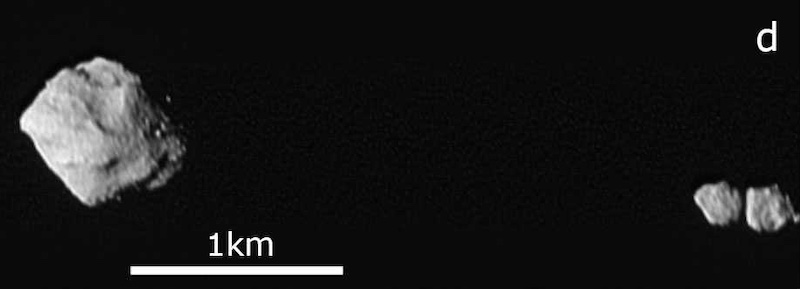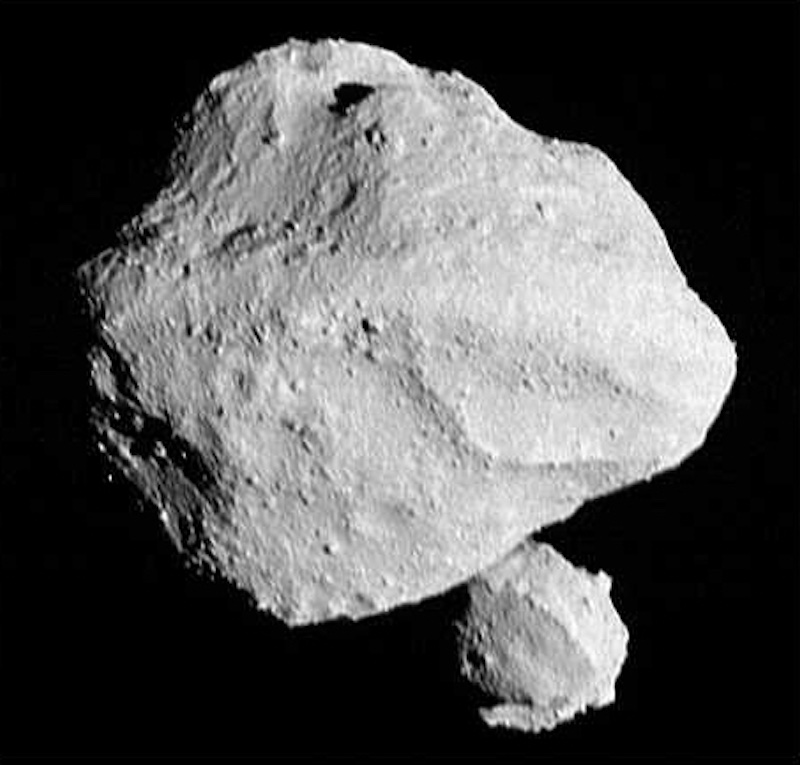
- A new study of asteroid Dinkinesh and its moon Selam, led by researchers at Southwest Research Institute, shows a complex geological history for both bodies.
- Data from NASA’s Lucy mission, which passed by Dinkinesh in November 2023, show ejected material from the larger asteroid likely formed its satellite, the dual-lobed Selam.
- Lucy will be visiting at least nine more asteroids during its mission, including eight Trojan asteroids near Jupiter.
Asteroid Dinkinesh and its lobed moon, Selam
When the NASA spacecraft Lucy visited the asteroid Dinkinesh in the main asteroid belt in November 2023, it made quite a discovery. It found Dinkinesh had a small companion moon, which researchers named Selam. A few days after that discovery, more images from Lucy showed Selam wasn’t just a single satellite but two fused together. A team led by researchers at Southwest Research Institute (SwRI) in Boulder, Colorado, recently studied data sent back by Lucy. They said on May 30, 2024, that new research shows how the asteroid’s double moon points to a complex history of all three mini-worlds.
The researchers published their findings in a new peer-reviewed paper in Nature on May 29, 2024.
Asteroid’s double moon
Scientists say Selam likely formed when material on Dinkinesh shifted, which created a trough on the asteroid and ejected material into space. Some material fell back on Dinkinesh and formed a ridge. Then, some of the other ejected material coalesced to form Selam. Astronomers aren’t quite sure how the satellite arrived at its current form of two lobes stuck together, or what scientists call a contact binary. But these closer looks at the ridged asteroid Dinkinesh and binary Selam suggest they have a lot of internal strength. Lead author Hal Levison at SwRI said:
This flyby showed us Dinkinesh has some strength and allowed us to do a little ‘archaeology’ to see how this tiny asteroid evolved. When it broke apart, a disk of material formed, some of which rained back onto the surface, creating the ridge.
Levison also said:
To understand the history of planets like Earth, we need to understand how objects behave when they hit each other, which is affected by the strength of the planetary materials. We think the planets formed as zillions of objects orbiting the sun, like asteroids, ran into each other. Whether objects break apart when they hit or stick together has a lot to do with their strength and internal structure.
So just how the material from Dinkinesh formed the lobed moonlet is still uncertain. As astrophysicist Kevin Walsh at SwRI explained:
We see ridges around asteroids’ equators regularly among near-Earth asteroids, but seeing one up close, around an asteroid with a satellite, helps to unravel some of the possible histories of these binary asteroids.
Asteroid’s double moon delivers data and delights
The Lucy flyby provided data and unexpected delights. Simone Marchi, Lucy deputy principal investigator and second author of the paper, said:
The Lucy science team started gathering data about Dinkinesh using telescopes in January 2023, when it was added to our list of targets. Thanks to the telescopic data, we thought we had quite a good picture of what Dinkinesh would look like, and we were thrilled to make so many unexpected discoveries.

More asteroids for Lucy
Lucy’s mission is far from over. There are nine more asteroids the spacecraft will explore over the next several years. Currently, it’s heading back toward Earth. It will use Earth’s gravity in December 2024 to slingshot out toward its next encounters. Its next target? Asteroid Donaldjohanson in 2025.
After that, it will head for its primary target, the Trojan asteroids. The Trojans share the same orbit as Jupiter, in swarms both ahead of and behind the planet. In 2027, Lucy will fly past no less than eight Trojan asteroids, in both swarms. Will Lucy find any more asteroids with moons? Or even double moons? Stay tuned!
When Lucy flew past Dininesh on November 1, 2023, it found some surprises. The larger asteroid has a small moon. And the moon is a pair of 2 smaller bodies fused together. Image via NASA’s Goddard Space Flight Center/ YouTube.
Bottom line: A new study of asteroid Dinkinesh and its moon, Selam, shows a complex history. Data from the Lucy mission provided a deeper insight of Dinkinesh and the asteroid’s double moon.
Source: A contact binary satellite of the asteroid (152830) Dinkinesh
Read more: Asteroid hunt by Hubble telescope using AI
Read more: Was asteroid Kamo’oalewa blasted from this moon crater?











